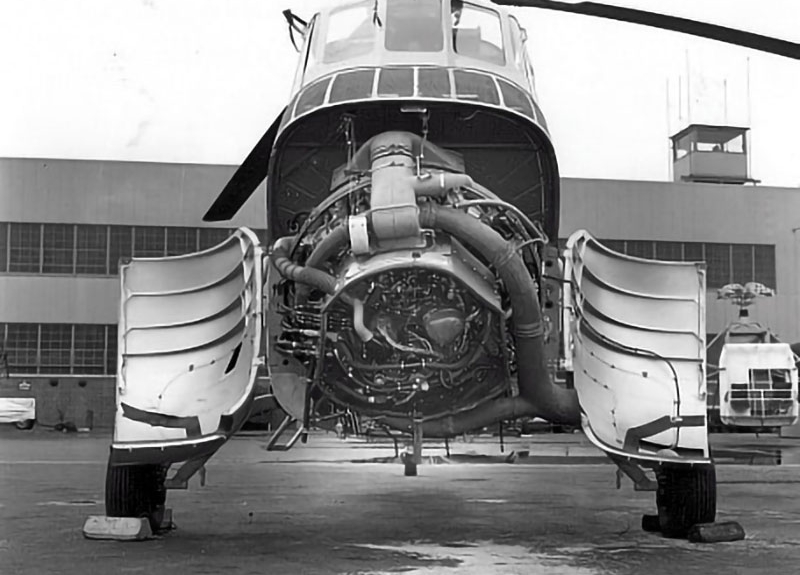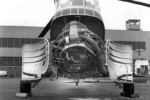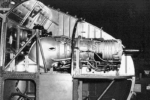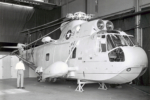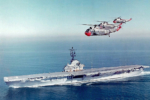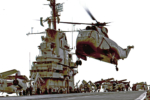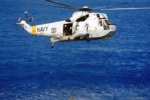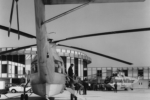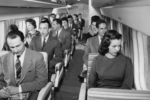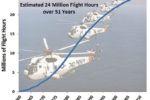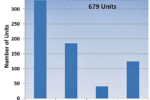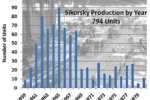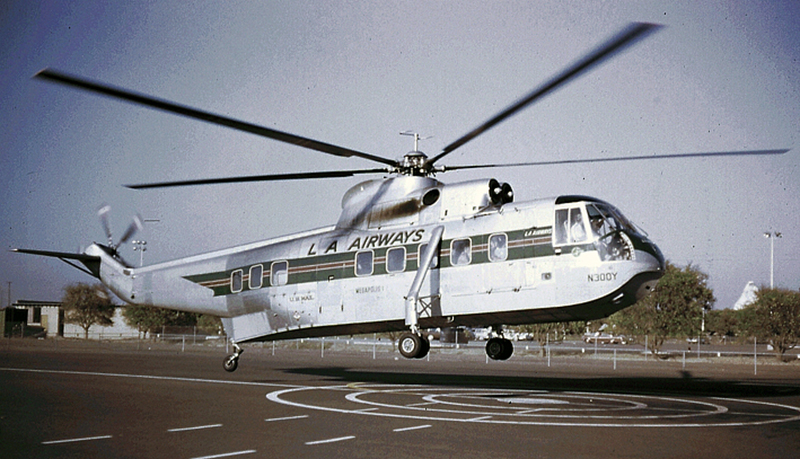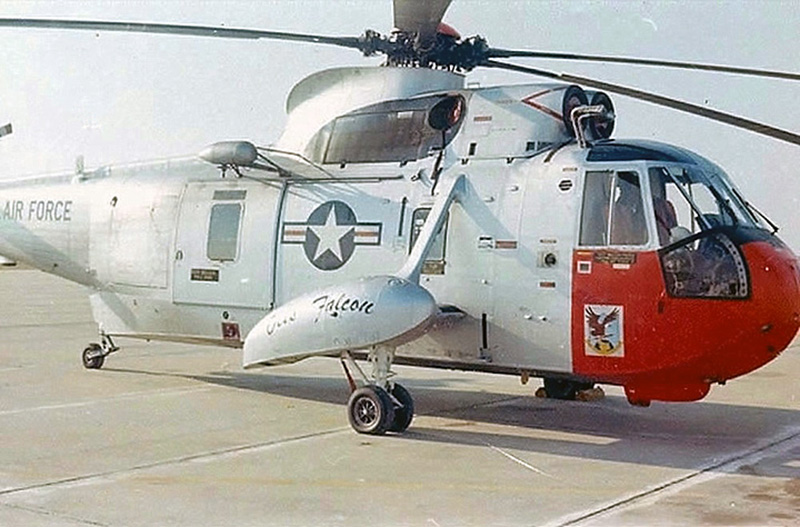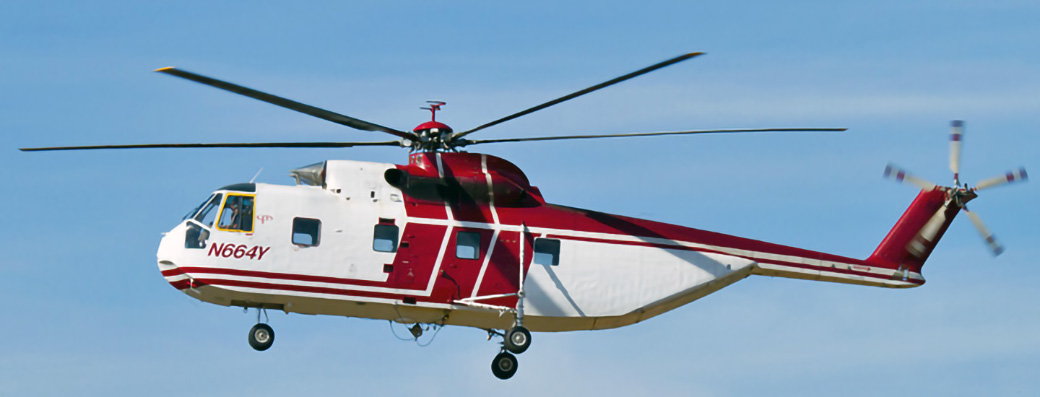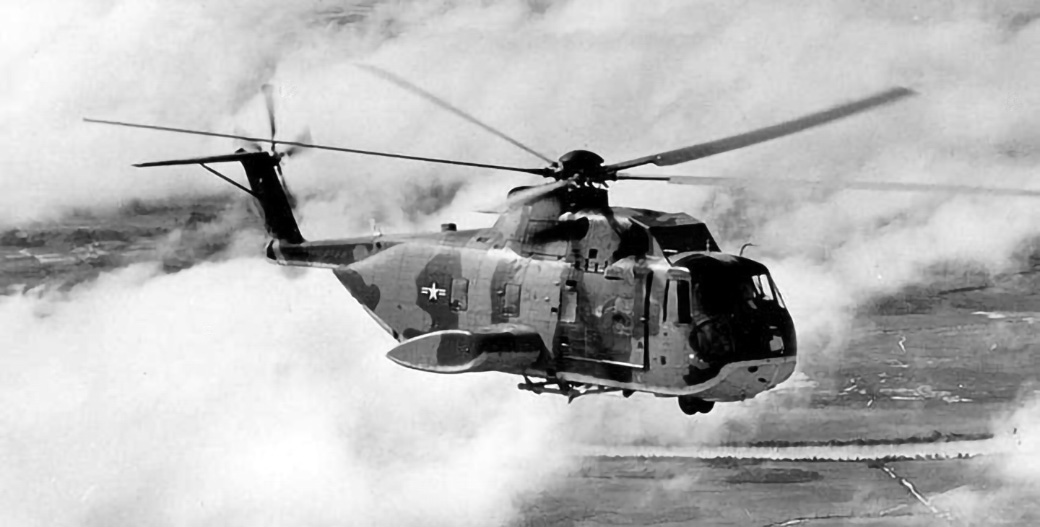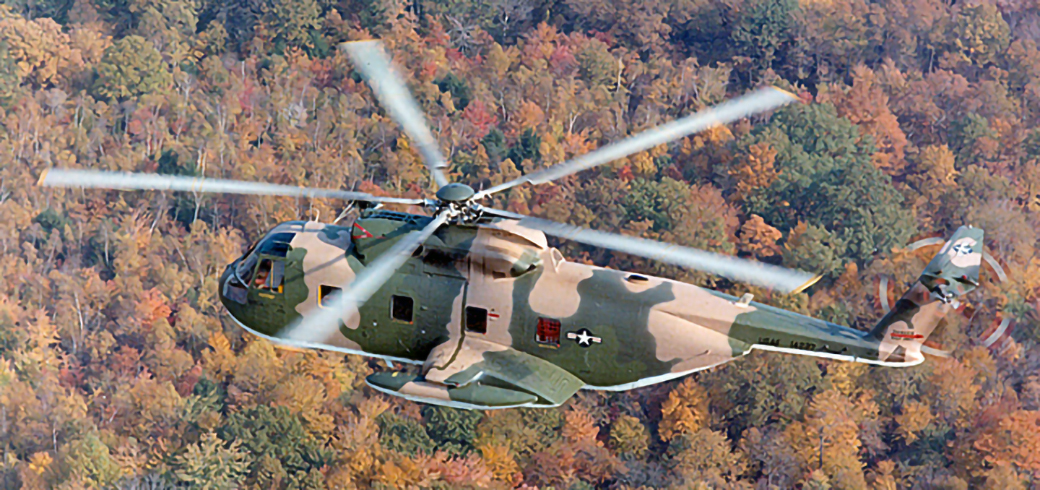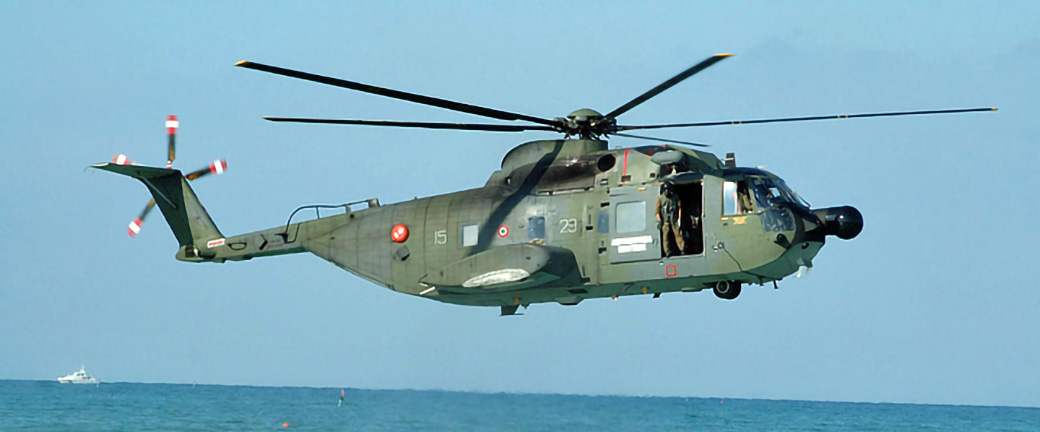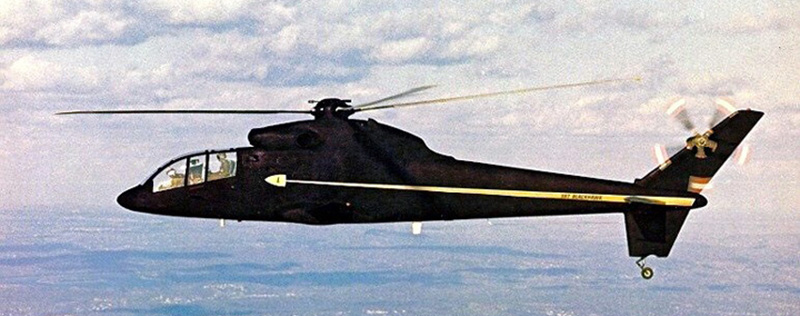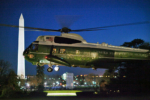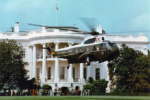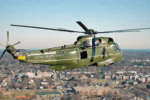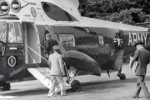Sikorsky Product History
Sikorsky S-61
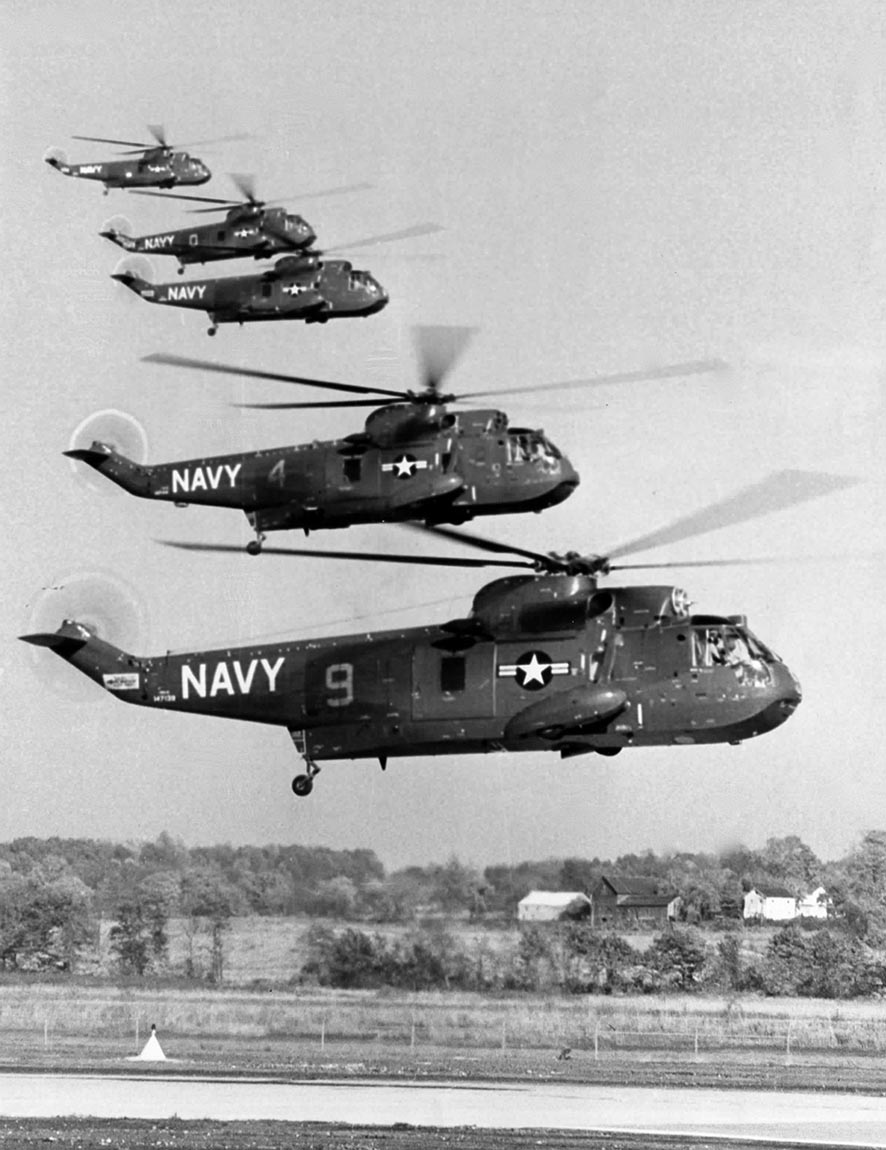
Background
The Sikorsky S-61 designation was assigned to the company’s first twin engine helicopter that was designed from the ground up to take full advantage of emerging turbo-shaft engine technology. This new model marked the end of reciprocating engine installations at Sikorsky and ushered in the era of the lighter and more compact turbine engines. The S-61 served all branches of the US Military as well as commercial airline service. It began its long production career as a model specifically tailored to anti-submarine warfare for the US Navy bearing the designation HSS-2. The model history described below focuses on this most important version of the S-61 helicopter series.
The threat of Soviet nuclear-armed submarines arose soon after the first Russian nuclear detonation in 1947 which immediately elevated anti-submarine warfare (ASW) to a mission of immense national importance. In 1950, at the height of the Cold War, the CIA noted an unconfirmed report that the only atomic bomb the Soviets had produced would have to be delivered by submarine. In 1955 the new Chief of Naval Operations, Adm. Arleigh Burke, asked the Committee on Undersea Warfare of the National Academy of Sciences to conduct an Anti-Submarine Warfare ASW study. That study, Project Nobska, concluded that “Confronted with quiet submarines of long endurance, a sufficiently accurate means of navigation, and suitable weapons, defense against shore bombardment by submarines becomes a huge problem.”
World War II experience in the North Atlantic demonstrated the futility of engaging submarines with surface vessels. The population of Nazi U-Boats peaked at 240 in 1943. Against this force, 875 sonar-equipped escorts could not conclusively prevail. There was a need to combine the sonar’s detection, localization, and targeting, with the speed of an aircraft.
One of the solutions was the ASW helicopter with active dipping sonar, a concept first demonstrated on a Sikorsky HOS (R-6) helicopter by the Naval Research Laboratory in 1946.
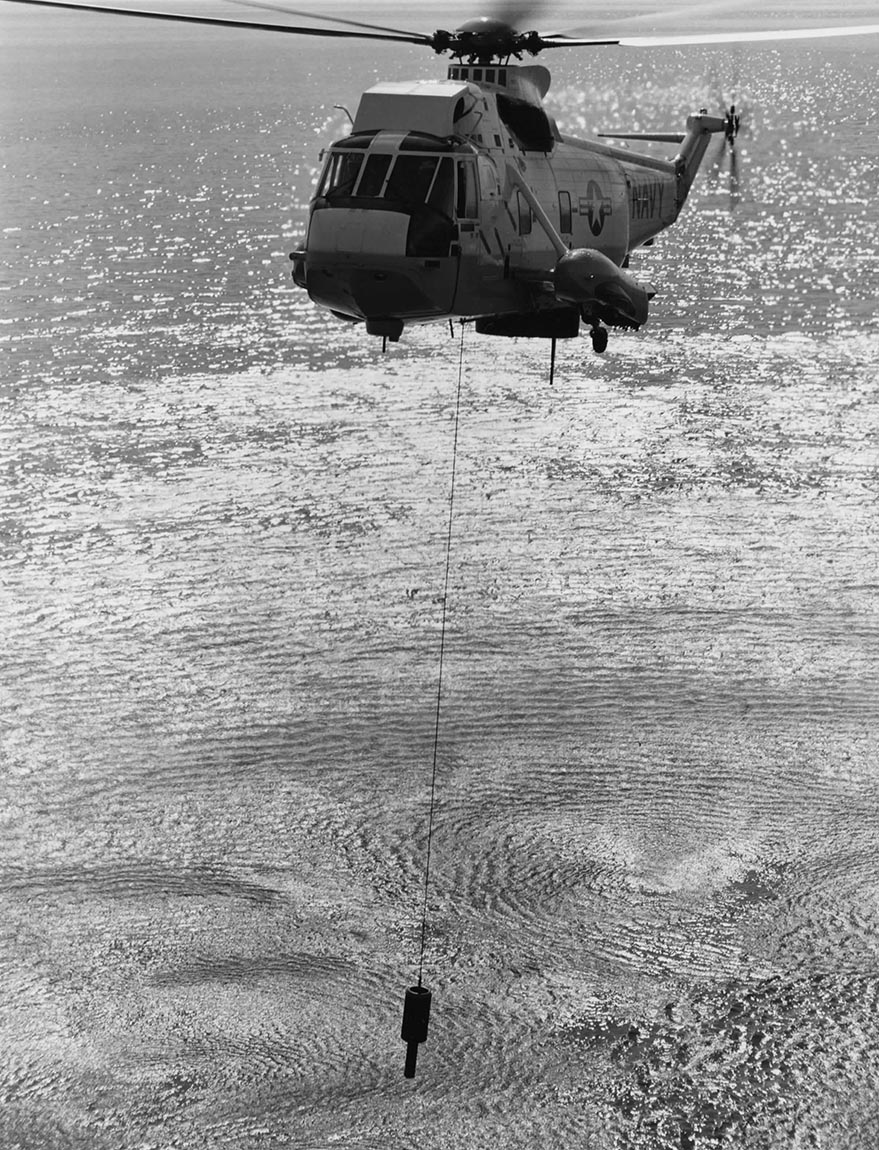
Starting in the early 1950’s, the U.S. Navy, Sikorsky and the Pacific Division of Bendix Aviation Corp. began developing the technology for helicopter ASW, combining the speed of an aircraft with underwater sonar previously based aboard ships. Using Sikorsky HSS-1 (H-34) helicopters, hunter-killer technology and tactics were developed and fielded. One helicopter carried a submersible sonar sensor and an airborne processor to detect, locate, and display the target; another helicopter carried a torpedo to address it. Space and payload limits prevented one helicopter from carrying both.
Simultaneously, the Navy recognized the need for improved helicopter engine technology and in 1953 awarded General Electric a $3M contract for the XT-58 “baby gas turbine.” The engine was to weigh 400 pounds and produce 800 HP, a two-to-one improvement over the legacy, reciprocating Wright R-1820 engine powering the HSS-1. The result exceeded expectations. The resulting engine weighed 324 pounds and generated more than 1,000 HP in a 10 cubic-foot package compared with the legacy piston engine of 62 cubic-feet.
The increase of almost four times the power/weight ratio in a compact 1/6th size permitted Sikorsky, for the first time, to truly tailor a helicopter to a mission, rather than tailor a mission to fit the payload and space remaining after the engine was installed.
In the mid 1950’s the U.S. Navy requested that Sikorsky modify an existing HSS-1N to accommodate two T58 engines in place of the R-1820. This was designated as the HSS-1F and showed the significant benefit of turbo-shaft engines over piston engines. The engines were not only lighter and smaller but provided 2,000 horsepower compared to the 1,525 available from the piston engine.
The benefits of the turbo-shaft were profound. The light weight and small size allowed the Sikorsky designers to place all of the mechanical components (engine, main gearbox, driveshaft, tail gearboxes, and tail rotor) on the top of the fuselage and freed the cockpit and cabin design to be tailored to the mission requirements. Heretofore, the major design problem had been the location of the heavy piston engine with the cockpit and cabin squeezed into the remaining space.
With this new engine, Sikorsky was able to offer the Navy, in place of the HSS-1F, the HSS-2, an all-new design beautifully tailored to the ASW mission. Sikorsky Engineering Report 61007 documenting the October 1957 HSS-2 Mockup Review reported:
“The success of the HSS-1 piston engine helicopter as an anti-submarine search and attack vehicle has prompted the Navy and Sikorsky Aircraft Division to enter into the next logical step, the development of a turbine powered modification of the HSS-1, which incorporates twin turbine engines, amphibious characteristics, all the technological and functional advantages gained through experience with the HSS-1, with capability of performing a combined Hunter-Killer ASW mission.
A new, low frequency, sonar (AQS-11) is being developed concurrently by the Pacific Division of Bendix Aviation Corp. as Contractor Furnished Equipment. This sonar together with the four (4) hour endurance HSS-2 constitute the major components of the first weapon system to meet Navy’s ASW requirements.
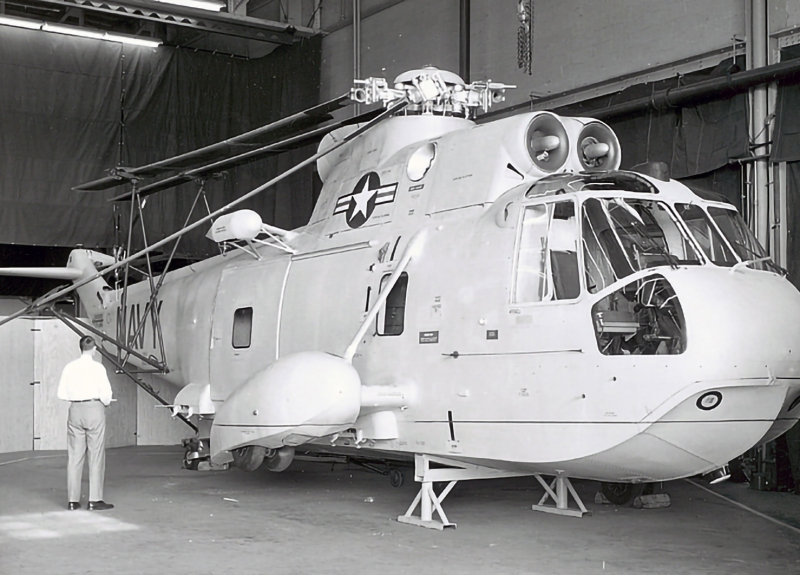


 SH-3A recovers Apollo 17 Astronauts December 19, 1972
SH-3A recovers Apollo 17 Astronauts December 19, 1972 The Sikorsky S-61L was the world’s first twin-turbine helicopter certified for commercial airline service. Los Angeles Airways began service in December 1961.
The Sikorsky S-61L was the world’s first twin-turbine helicopter certified for commercial airline service. Los Angeles Airways began service in December 1961. For airline service, the Sikorsky S-61L carried between 24 and 30 passengers depending on seating arrangement
For airline service, the Sikorsky S-61L carried between 24 and 30 passengers depending on seating arrangement
The Bendix dipping sonar system consisted of a sonar reeling machine, a reel of 500 feet of sonar cable, the submersible sensor, sonar data processing and display equipment, and a sonar operator control console. The HSS-2 also featured navigation and mission avionics and sensors to provide automated approach to, and maintenance of, a hover stabilized above the submersed sensor and provisions for carrying and firing torpedoes. This powerful mission suite was enclosed in an airframe with hull and sponson flotation based on the iconic Sikorsky Pan American Clipper flying boats with which Pan American Airlines had pioneered international transoceanic air travel two decades earlier.
Configuration Features
The HSS-2 was primarily intended for the ASW mission, but Marine Assault and Army Transport missions were also considered. Sikorsky Engineering Report 61003, Engineering Basic Data Report Model HSS-2, HUS-2, H34B Helicopters, 2/26/57 states:
General design objectives are:
- Design to accomplish given missions
- Minimum weight
- Component life and Reliability
- Minimum drag and cleanest external surface
- Ease of maintenance
- Manufacturing simplicity
The most distinctive feature of the Sikorsky S-61 series is the use of a boat hull with outboard floats (called sponsons). The hull design with a 12 degree deadrise angle was derived from Sikorsky’s extensive experience in flying boat design. The outboard sponsons significantly increased the lateral stability in the water. The main landing gear retracted into the sponsons and water take-off and landings were performed with the gear retracted. To increase lateral stability and buoyancy, inflatable floats were added to the outsides of the sponsons.
The other significant configuration item was mounting of the engines and drivetrain above the cabin. This completely separated the cockpit and cabin from the machinery and reduced noise while increasing safety compared to the prior piston engine designs. As noted earlier, this was due to the significant reduction in the size and volume of the turboshaft engines.
The S-61 (HSS-2) was Sikorsky’s first model to employ a main transmission capable of providing almost 100- to-1 reduction ratio needed for the turbo shaft engine’s high, 20,000 rpm, output speed. Prior MGBs had reduction ratios of only 10 or 12- to-one reflecting the much lower output speeds of piston engines. Higher engine output speed forced advancements in free wheel unit technology and high speed bearings.
The main rotor head featured technology previously proven on the S-58, such as basic rotor configuration and the NACA 0012 airfoil, but for the first time offered oil-lubricated rotor bearings, a departure from the previous grease lubrication scheme. Oil lubrication eliminated the need for periodic grease system maintenance. Another important feature of the HSS-2 was the fully automatic main rotor blade fold. Along with simple manual fold of the tail rotor pylon, this allowed for a convenient, compact placement aboard ship. The rapidity and reliability of the blade fold was important operationally and became more so when S-61s were operated from vessels smaller than the ASW carriers on which they were initially deployed.
Automatically stabilized flight and an automated approach to, and maintenance of, a stable hover had been developed in the previous S-58 and S-56 models. An Automatic Stabilization System, ASE, provided electronically stabilized flight. A coupler provided the autopilot functions to automatically approach and maintain a hover fifty feet above the ocean surface, into the wind, stabilized relative to the sonar cable supporting the submerged sonar transducer. A radar altimeter provided altitude; a Doppler radar system provided airspeed data for stabilization and auto approach. Earlier ASE and Coupler systems had consisted of vacuum tube circuits. For the first time HSS-2 systems were fully transistorized solid state circuits.
The HSS-2 was fitted with a two-piece personnel door on the left side, just aft of the cockpit. It also had a large siding door on the right side in the aft cabin. This greatly aided in moving equipment in and out of the cabin.
General Arrangement Drawing
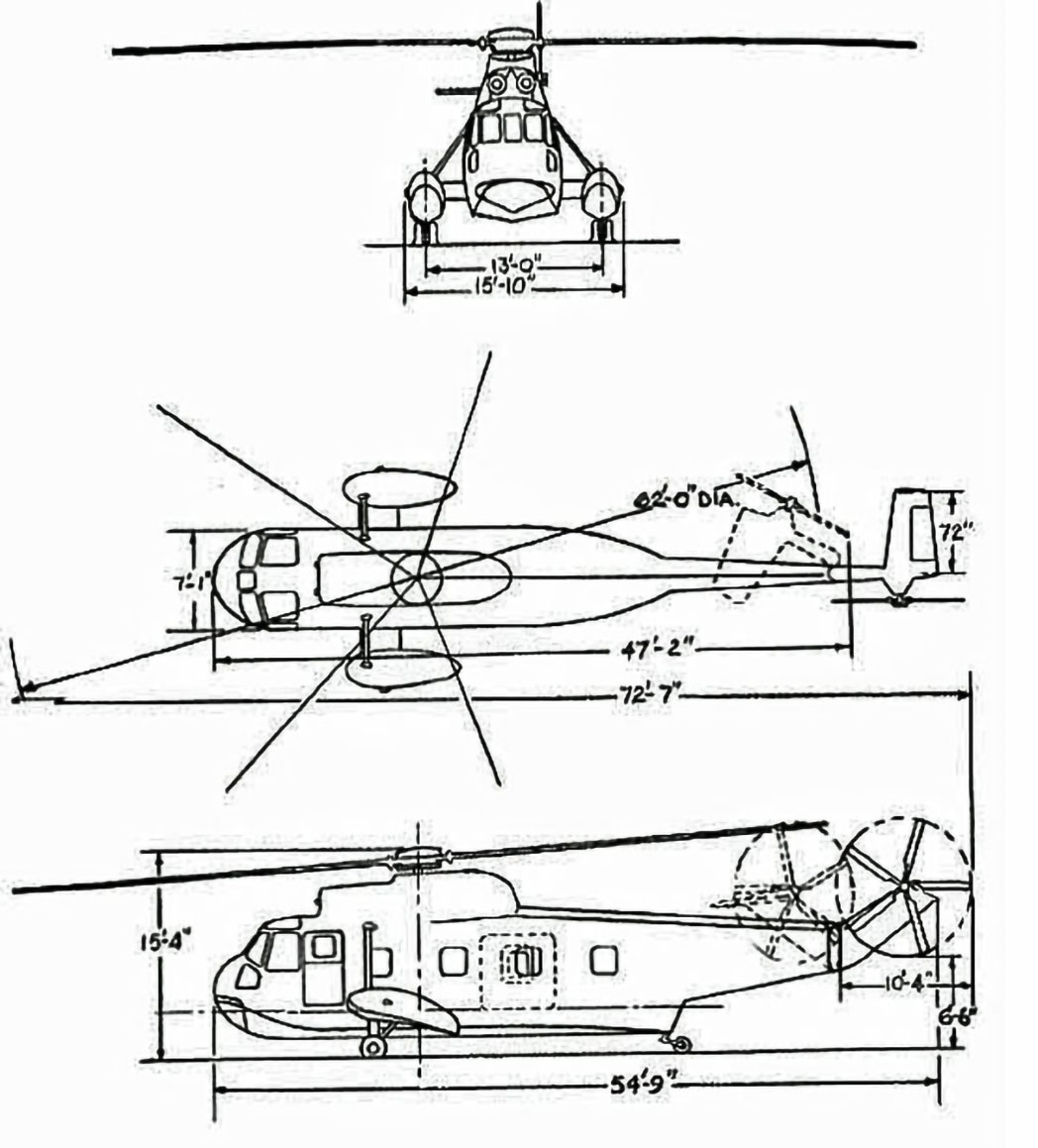
Mission Equipment
The HSS-2 was equipped with a comprehensive suite of mission electronics that allowed it to track submarines in all weather, day and night. This equipment included:
| Designator | Mission Equipment |
|---|---|
| AN/AQS-10 | Dipping Sonar |
| AN/APN-117 | Radar Altimeter |
| AN/APN-130 | Doppler Radar |
| AN/APX-6 | IFF |
| AN/ARA-25 | UHF ADF |
| AN/ARC-39 | Low Frequency ADF |
| AN/ARC-52 | UHF Radio |
| AN/ARN-21 | TACAN |
| AN/ASA-13 | Navigation Plotter |
| AN/AYK-2 | Navigation Computer |
General Characteristics and Performance
| Performance Standard Day At Sea Level | |
|---|---|
| Maximum Speed (Vne) | 135 kt |
| Normal Cruise Speed | 125 kt |
| Service Ceiling | 14,000 ft |
| Combat Endurance | 4 hrs |
| Weights | |
|---|---|
| Design Gross Weight | 16,237 lb |
| Alternate Gross Weight | 19,000 lb |
| Limit Load Factor DGW | +2.5g/-0.5g |
| Limit Sink Speed | 8 fps |
| Engines | |
|---|---|
| Number | 2 |
| Manufacturer | GE |
| Model | T58-GE-6 |
| Normal Rated Power | 900 hp |
| Military Power | 1,050 hp |
| Aircraft Dimensions | |
|---|---|
| Length, rotors turning | 72′ 7 |
| Height, rotors turning | 16′ 10 |
| Width, over sponsons | 16′ 0 |
| Length, folded | 46′ 6 |
| Height, folded | 16′ 10 |
| Width, folded | 16′ 0 |
| Main Rotor Diameter | 62′ 0 |
| Main Rotor Number Blades | 5 |
| Main Rotor Chord | 18 ¼” |
| Main Rotor Solidity | 0.0738 |
| Main Rotor Rotor Speed (100%) | 203 rpm |
| Tail Rotor Diameter | 10′ 4” |
| Tail Rotor Number Blades | 5 |
| Tail Rotor Chord | 7 11/32” |
| Tail Rotor Solidity | 0.1885 |
| Tail Rotor Speed (100%) | 1,244 rpm |
| Horizontal Tail | |
| Horizontal Tail Span | 6′ 0 |
| Horizontal Tail Area | 20.0 sq ft |
| Horizontal Tail Taper Ratio | 1.5:1 |
| Horizontal Tail Aspect Ratio | 1.8 |
| Landing Gear Type | Retractable |
| Landing Gear Configuration | Tail Wheel |
| Landing Gear Tread | 13′ 0 |
| Landing Gear Wheelbase | 23′ 4 |
Production History
The Sikorsky model designation for the HSS-2(SH-3A) is the S-61. Since 1959, Sikorsky Aircraft has produced 794 aircraft based on the original S-61. At the end of twenty years production, Sikorsky produced the last S-61 in 1981 for the Spanish Navy. Sikorsky licensees in Great Britain, Japan, Canada, and Italy have produced an additional 679. It is estimated that up until 2010 S-61s had flown more than 24 million hours in military service and civil use.
Production by Model (Non-Licensed)
| Sikorsky No | Design | Quantity |
|---|---|---|
| S-61 | XHSS-2 | 10 |
| S-61 | HSS-2 (SH-3A) | 245 |
| S-61B-1 | CHSS-2 (CH-124) | 41 |
| S-61 | HSS-2Z (VH-3A) | 8 |
| S-61A | CH-3B | 3 |
| S-61A | S-61A | 52 |
| S-61D | YSH-3D | 4 |
| S-61D | SH-3D | 96 |
| S-61D | VH3D | 11 |
| S-61D | S-61D | 15 |
| S-61R | CH-3C | 74 |
| S-61R | CH-3E | 45 |
| S-61R | HH-3E | 14 |
| S-61R | HH-3F | 40 |
| S-61L | S-61L | 13 |
| S-61N | S-61N | 123 |
| Overall Total | 794 |
Related Models
S-61 Commercial Models
S-61 Military Models
S-61R Models
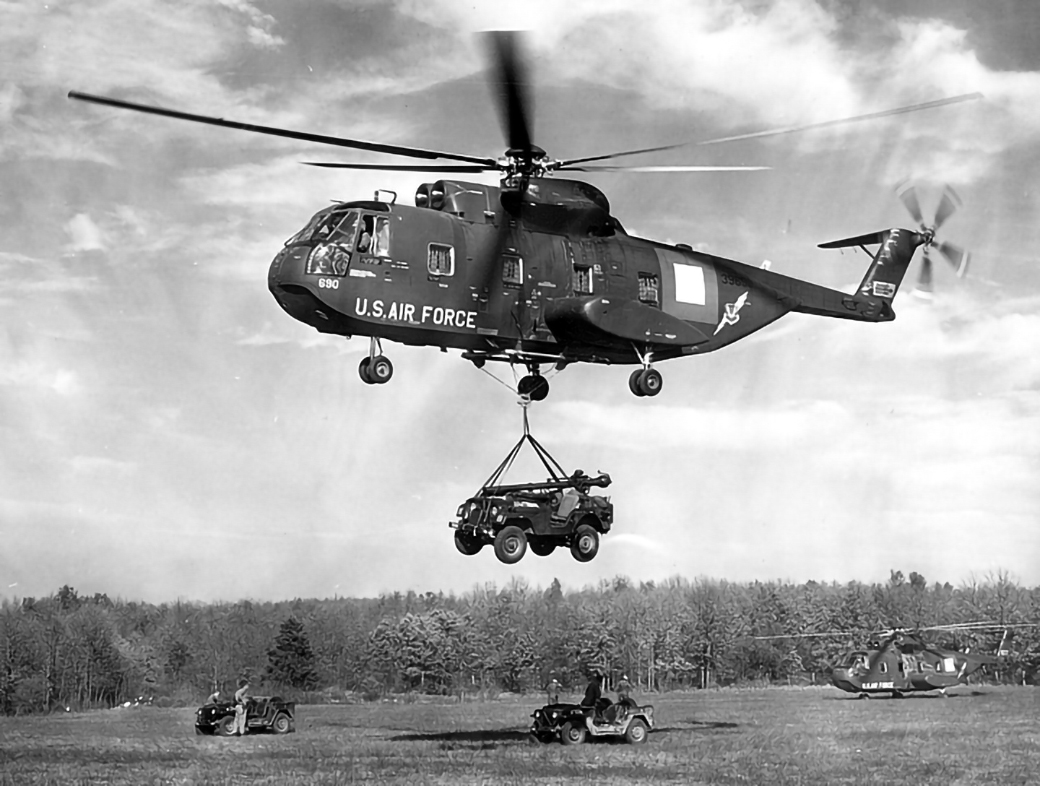
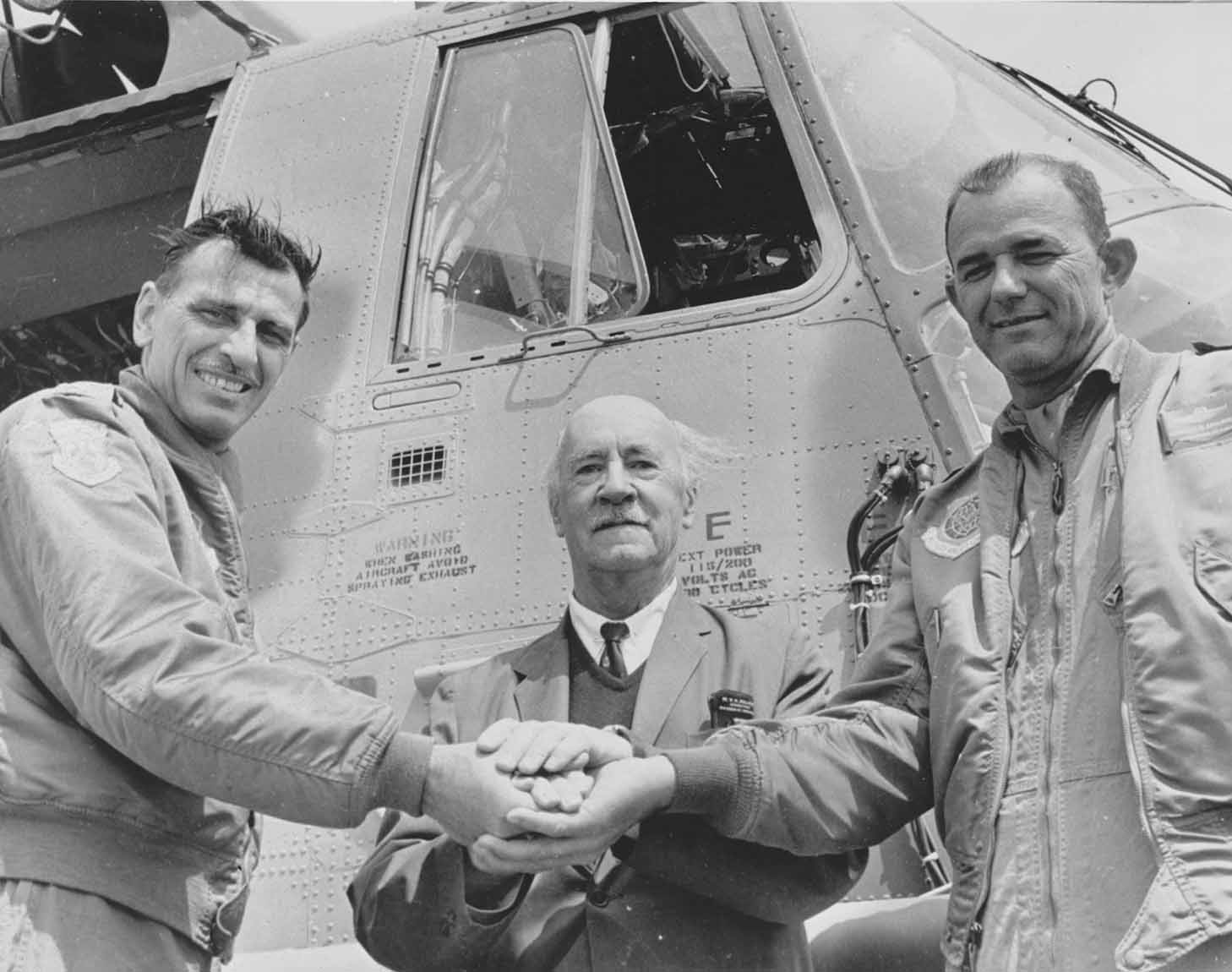
- Doppler (Ground Speed and Drift)
- TACAN (Distance and Bearing)
- LORAN “A” Auto-track
- Magnetic Heading
- True Airspeed
- Present Position
- Destination Bearing
- Destination Range
- Along Track Distance
- Cross Track Error
- Track Angle
- Wind Velocity
- Wind Direction
- True Airspeed
- Magnetic Heading
- Estimated Time Enroute
- Arrive Destination
A Map Display required the pilot to insert a standard paper air navigation chart and the computer provided a continuous indication of present position by a “Bug Light” and provided a permanent record of the flight by pin punching the chart every 10 seconds.
The HH-3F Pelican was the workhorse of the U.S. Coast Guard. Serving from the early 1969 until well into the late 1994, the HH-3F is credited with saving 23,169 lives and assisted 65,377 others. With a speed of 142 knots and a maximum range of 650 nautical miles, the HH-3F was well suited to its amphibious, all weather search and rescue duties. A common phrase among USCG Aircrewman was “Only God has saved more lives”.
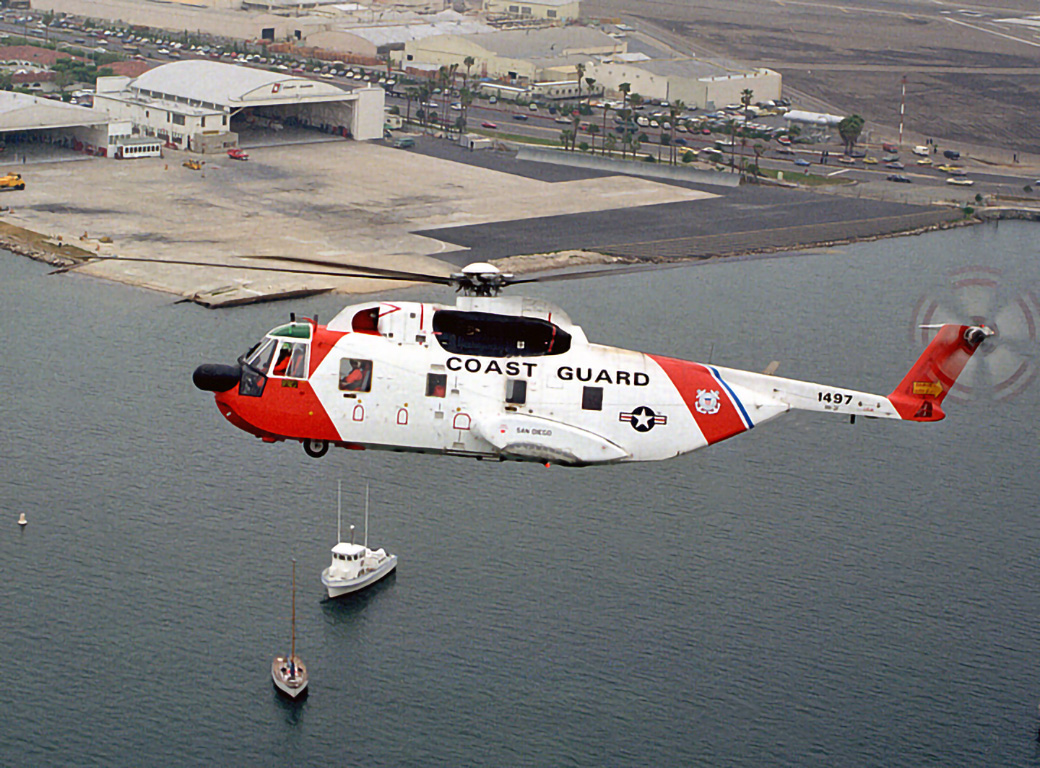
VH-3A/D Presidential Helicopters
By far, the most familiar HSS-2 derivative is the Marine Helicopter Squadron One (HMX-1) Executive Flight Detachment VH-3D Marine One helicopter with its distinctive white top. (The white tops date from HMX-1 VH-34C helicopters first used in the Eisenhower administration. Without air conditioning, the original white tops were intended to deflect heat for a cooler interior.) The VH-3’s featured communication equipment, executive furnishings, and air conditioning tailored to the mission. This aircraft transports the President of the United States, other members of the Executive Branch, and other VIP’s. Sikorsky delivered the first VH-3A in 1962. An upgraded derivative, the VH-3D, continues this proud service today.
The VH-3A helicopters as they were removed from HMX-1 duties were distributed to museums and one was given to Anwar Sadat, the President of Egypt, a gift from President Nixon. Other went to U.S. Navy for use as VIP transports. The last operational VH-3A assigned to HSC-2, Norfolk to ferry Admirals to the Pentagon and other missions as required. The HSC-1 VH-3A flew its final mission on January 27, 2006.
VH-3D equipment includes Day/night/all-weather operations, self-contained navigation system, GPS, TCAS, survivability systems, and crash-survivable flight information recorder sensor, and carries no weapons. Communications include extensive secure and non-secure communication systems; and EMP hardening. The last VH-3D helicopter was delivered in 1976. The VD-3D helicopters are supported by Sikorsky Aircraft which provides a closed loop supply system and a scheduled depot level maintenance program (Special Periodic Aircraft Rework). The helicopters are brought back to “Like New” condition during each SPAR and systems modernized as new technology develops.
Augusta ASH-3D/TS
In Italy, Augusta built 2 helicopters, under license, similar to the VH-3A for the Italian Air Force to provide transportation for the Pope. This helicopter served The Holy See causing some to call it a “Holy See King” rather than a “Sea King”.
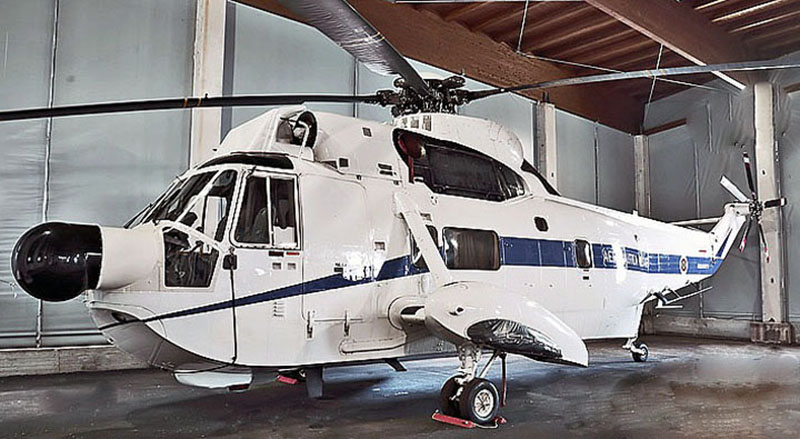
The ASH-3D/TS helicopters of the Italian Air Force Volo Papale (Papal Flight) carried the Pope for 37 years (1975-2012). In October, 2012 the ASH-3D helicopters were replaced by the much smaller AW-139.
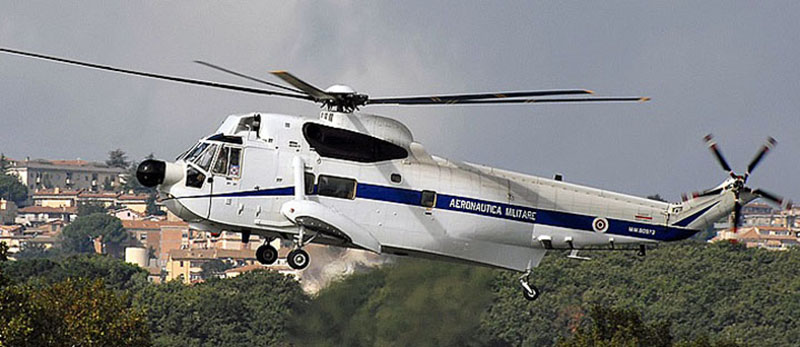
S-61T
The S-61 helicopter lives on. In 2010, 29 years after delivering the last S-61 helicopter, Sikorsky Aircraft received a Department of State contract for remanufactured S-61N and S-61T Triton helicopters. The contract was a 5 year Indefinite Delivery-Indefinite Quantity contract for up to 110 modernized S-61 helicopters. The first deliveries of two S-61N helicopters was completed on June 10, 2010. The S-61T Program is managed by Sikorsky Aerospace Services.
Notable Accomplishments for Sikorsky S-61 Series
| Year | S-61 Model | Notable Accomplishments |
|---|---|---|
| 1959 | SH-3A | First single rotor helicopter with 5 blades First helicopter with automatic blade fold First to be able to simultaneously hunt and kill submarines (dipping sonar + torpedoes) |
| 1960 | S-61L | First helicopter designed specifically for airline use |
| 1961 | SH-3A | Set world’s speed record for helicopters: 3 km sea level speed record (192.9 mph) 100 km speed record (183 mph) 500 km speed record (179.5 mph) 1,000 km speed record (175 mph) |
| 1961 | SH-3A | First deliveries to U.S. Navy |
| 1961 | S-61L | World’s first multi-turbine helicopter certified for passenger transport. |
| 1961 | Mod SH-3A | Set new speed records (with sponsons removed): 3 km sea level speed record (198.8 mph) 25 km speed record (210.6 mph) |
| 1962 | S-61L & N | First civil helicopters certified as IFR transports |
| 1962 | VH-3A | Presidential transport helicopters delivered |
| 1965 | S-61R | First helicopter operational in-flight refueling |
| 1965 | S-61F | Experimental compound version achieves 204 knots (6 bladed rotor, two J69 jets) |
| 1965 | SH-3A | First flight minesweeping version |
| 1965 | RH-3A | First helicopter to fly non-stop across Atlantic (with 9 In-flight refuelings) |
| 1967 | HH-3E | Apollo 11 astronauts recovered by SH-3D “66” of squadron HS-4. The first of many such recoveries by the SH-3D |
| 1969 | SH-3D | SH-3H remanufacturing program initiated |
| 1971 | SH-3H | Last S-61 produced at Sikorsky after 20 years in production |
Configuration Summary
| Military | Civil | Fuselage, Landing Gear | Horiz. Tail | Tail Rotor | Sponson | Max Gross Weight |
|---|---|---|---|---|---|---|
| S-61A | Short, TW | small | small | small | 19000 | |
| SH-3A | S-61B | Short, TW | small | small | small | 19000 |
| VH-3A | S-61V | Short, TW | small | small | small | 19000 |
| CH-3B | Short, TW | small | small | small | 19500 | |
| CH-3C | S-61R | Ramp, Tri | large | small | Stub wing | 22050 |
| SH-3D | S-61D | Short, TW | large | large | small | 21500 |
| H/CH-3E | Ramp, Tri | large | small | Stub wing | 22050 | |
| HH-3F | Ramp, Tri | large | small | Stub wing | 22050 | |
| SH-3G | Short, TW | large | large | small | 21500 | |
| U/SH-3H | Short, TW | large | large | long | 21500 | |
| S-61L | Long, TW | large | small | strut | 20500 | |
| S-61N | Long, TW | large | large | large | 20500 | |
| S-61T | Short, TW | large | large | strut | 20500 |
Long Fuselage – S-61L & S-61N civil versions, 50 inches longer than short
Rear Ramp – S-61R new design with tricycle LG, 39.5 inches longer than short
Small Horizontal Tail – 20 sq ft, no strut
Large Horizontal Tail – 27 sq ft with strut
Small Tail Rotor – 10ft 4in diameter
Large Tail Rotor – 10ft, 7.25in diameter
Small Sponson – original to SH-3A, 2,200 lb displacement each
Large Sponson – used on S-61N, 3,200 lb displacement each
Long Sponson – same as small, extended aft to hold towed MAD or sonobuoys
Strut – fixed landing gear on S-61L
Stub Wing – S-61R retracts LG into sub wings on aft fuselage
TW – Tail Wheel
Tri – Tricycle
Propulsion Summary
| Military | Civil | Engine | Continuous HP per Engine | Max HP per Engine | MGB HP Limit |
|---|---|---|---|---|---|
| SH-3A | S-61A | T58-GE-8B | 1050 | 1250 | 2300 |
| VH-3A | S-61V | T58-GE-8B | 1050 | 1250 | 2300 |
| CH-3B | T58-GE-8B | 1050 | 1250 | 2300 | |
| CH-3C | S-61R | T58-GE-5 | 1400 | 1500 | 2500 |
| SH-3D | S-61D | T58-GE-10 | 1250 | 1400 | 2500 |
| VH-3D | T58-GE-400 | 1400 | 1500 | 2500 | |
| H/CH-3E | T58-GE-5 | 1400 | 1500 | 2500 | |
| HH-3F | T58-GE-5 | 1400 | 1500 | 2500 | |
| SH-3G | T58-GE-10 | 1250 | 1400 | 2500 | |
| U/SH-3H | T58-GE-402 | 1400 | 1500 | 2500 | |
| S-61L | CT58-110 | 1050 | 1250 | 2300 | |
| S-61N | CT58-140 | 1400 | 1500 | 2500 | |
| S-61T | CT58-140 | 1400 | 1500 | 2500 |
HP – Horse Power
MGB – Main Gear Box
Note on US Naval Aircraft Designations.
The first S61 model carried the US Navy designation HSS-2. H for helicopter, first S for antisubmarine, second S for Sikorsky, and -2 denoting the second model in the series, since the HSS-2 was preceded by the S-58 HSS-1. In 1962 Navy modified their designation pattern so that the HSS-2 became the SH-3, with S for antisubmarine and H for helicopter.
Additional Information Sources
Information on mid-20th-century anti-submarine warfare was obtained from: The Third Battle: Innovation in the U.S. Navy’s Silent Cold War Struggle with Soviet Submarines, March 2000, by Owen Cote Jr., Director, MIT Security Studies Program, to whom the author is most grateful.
Color photos were obtained from the extensive Wikipedia files for the Sikorsky SH-3 Sea King, Sikorsky S-61R, Sikorsky VH-3, and Sikorsky S61L, for which the author is most grateful.
by Jim Bohan & Tom Lawrence
Related Articles
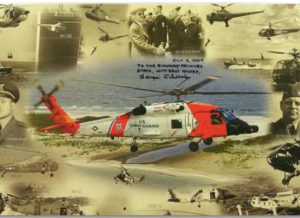
Sikorsky Serves the Coast Guard
A flight demonstration of Igor Sikorsky’s VS-300A helicopter at Bridgeport, Connecticut in April 1942 started an air-sea rescue revolution in the U.S. Coast Guard.
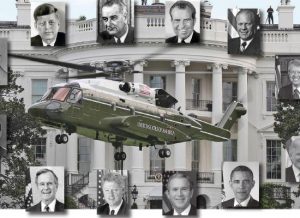
Sikorsky Serves the Presidents
Sikorsky Aircraft has engineered, built, and supported the Presidential helicopters since 1957.
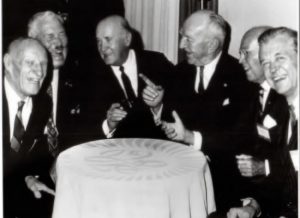
Predictions of a Pioneer
Igor Sikorsky’s predictions for air travel in general and for helicopters in particular have been largely realized or surpassed.
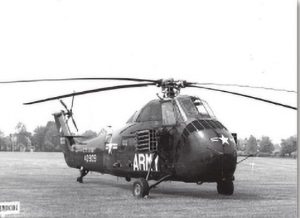
Evolution of the Armed Helicopter
Military users quickly understood the flexibility and fire-power of rotary wing platforms and ultimately evolved highly integrated weapons systems ready to protect themselves and others.

Sikorsky Helicopters in U.S. Air Force Rescue Squadrons
The HH-60W Combat Rescue Helicopter is the latest in the life-saving line of Sikorsky helicopters made for U.S. Air Force Rescue Squadrons. The Whiskey will round out a century of vertical flight rescue heroism.
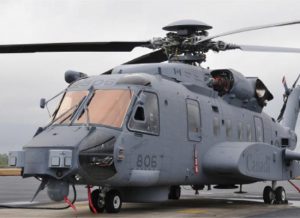
Sikorsky’s Sub Hunters
Today’s MH-60R gives the U.S. Navy the world’s most advanced ASW helicopter. However, the potential of the helicopter in ASW was recognized even before the Navy and Coast Guard flew their first Sikorsky R-4s in World War II.
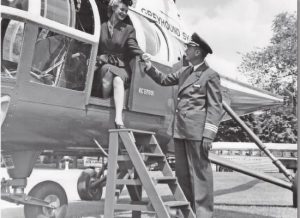
Sikorsky Helicopters in Airline Service
Early in the evolution of Sikorsky helicopters, Igor Sikorsky and his team envisioned scheduled passenger flights serving major cities.
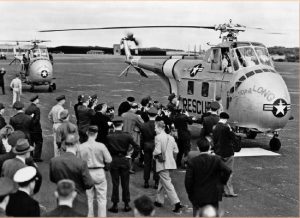
Sikorsky Aircraft Cross the Atlantic
This issue of the newsletter recognizes the anniversaries of a VS-44A flying boat setting a record for crossing the Atlantic non-stop; S-55 helicopters self-deploying to Europe; and S-61 helicopters flying non-stop to Paris.
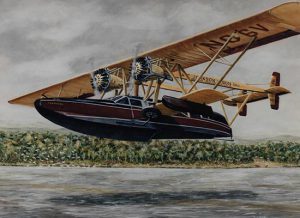
Sikorsky Aircraft Color Schemes
This issue of the newsletter illustrates some of the artistic variations in the exterior color schemes of aircraft delivered during Igor Sikorsky’s three careers.

U.S. Coast Guard and Sikorsky Celebrate Significant Events
The United States Coast Guard and Sikorsky Aircraft celebrated two significant events in 2016. One century of United States Coast Guard aviation and the 127th birthday of Igor Sikorsky.
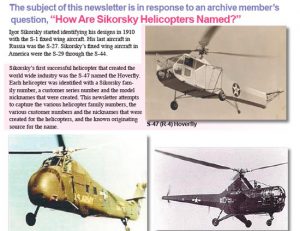
How Sikorsky Helicopters Are Named
The subject of this newsletter is in response to an archive member’s question, “How Are Sikorsky Helicopters Named?”
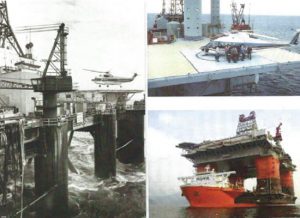
Revolutionizing Transportation in the 1950s
Igor Sikorsky’s large cabin single main rotor helicopters revolutionized the energy, health and other industry’s transportation requirements during the 1950s.

